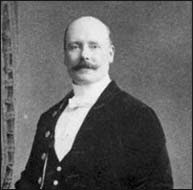At the opening of the Twentieth Century, John Phillip Sousa was a famous man. The previous year he had represented the United States at the Paris Exposition, after which he embarked on a long tour of Europe. He was arguably the best-known American entertainer in the world and wherever he went he found that influential people were keen to meet him and introduce him as a friend.
July of 1901 found Sousa in London. As a guest at the Savile Club, Sousa was introduced to William Butler Yeats, the poet. Yeats was a member of the Savile, and like many of the Savile's members at the time he had a keen interest in the occult. Sousa also had a long-standing interest in Astrology and occult topics. In the free-wheeling company of the artists, writers and scientists who frequented the Savile, this interest briefly blossomed into a collaborative project between himself and Yeats.
Yeats believed sincerely in the practice of magic, and conducted various experiments in 'summoning spirits' which he believed would channel poetry or important messages through him. Yeats proposed to Sousa that they do the same with music.
They jointed conducted a series of seances in which they engaged in automatic writing. Yeats was charged with contacting the 'spirits' and channeling their responses through his hand, which was resting on the top of Sousa's head. Sousa, who was blindfolded, scribbled notes on sheet music during these sessions.
The result was a musical composition which Yeats formally titled 'A Hermetic Instruction in Sight,' although others invariably referred to the piece as 'The Devil's March.'
It was performed only once before a small, private audience at the Savile. Sousa himself is said to have played the trumpet for part of the performance, which included only a small number of the musicians of his usual big band. H. Rider Haggard described the piece as "... a terrifying, hypnotic sort of bugling and thunder."
Sir E. A. Wallis Budge stood up and left the room shortly after the performance began, later explaining that he was concerned for his female companion's sanity if she remained in the presence of such demonic noises any longer.
The stunned audience clapped politely and the Devil's March was never heard again. Sousa later told his son, John Philip Sousa, Jr, that he feared where the music might have actually come from and destroyed all of his copies of the score. Yeats was reported to possess copies, including the original transcriptions made during their seances. If a copy still exists, it has not been brought to the attention of modern musicologists.
The following year, Sousa wrote and published a novel entitled, 'The Fifth String.' It is the story of a man who receives a violin from the Devil. The violin makes enchanting music, but to play upon its unusual 5th string will cause the musician to die. Naturally, the protagonist eventually does exactly that and the devil gets his due in the end.
John Phillip Sousa lived a reasonably long life, dying of what appeared to be natural causes at the age of 77. The final disposition of his soul is, naturally, unknowable. But one wonders exactly what the price was for Sousa's Devil's March.
Friday, June 26, 2009
Subscribe to:
Post Comments (Atom)

Everyone was doing seances back then. It was a fad and this was nothing strange at the time. The NAtional library of Ireland could probably dig up his copies of the score to the devil's march. They have his papers I think.
ReplyDeletecheap gucci belts
ReplyDeletecoach factory outlet
hollister outlet store
jordan 3
fitflop shoes
rolex watches prices
nike outlet store
nike shoes
jordan 11
celine outlet
dior outlet
cheap nike shoes
canada goose sale online
michael kors outlet online sale
nike clearance
north face outlet
vans shoes sale
abercrombie outlet
hermes outlet
rolex watches for men
michael kors handbags clearance 75% off
michael kors outlet
air jordan 13
fitflop sandals for women
cheap nfl jerseys
burberry sale
michael kors handbags
ghd hair
coach diaper bag
nike factory store
hermes outlet
canada goose discount
jordan retro 6
ferragamo sale
jordan 13
clarks outlet
cheap nike air max
cheap nike air max
prada outlet
coach handbags outlet
air jordan 6
christian louboutin shoes
chanel bags
coach sale
20151016yxj-2